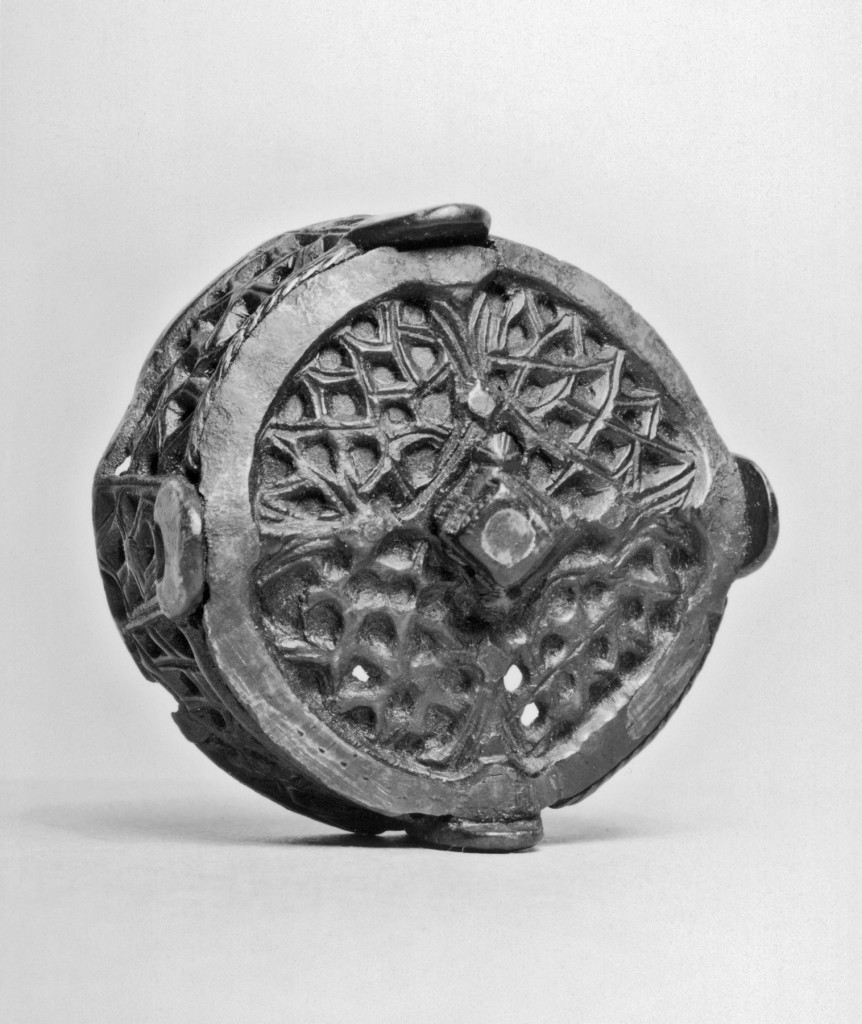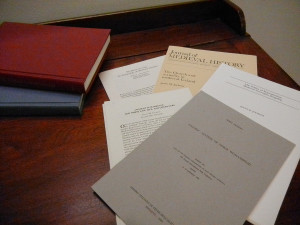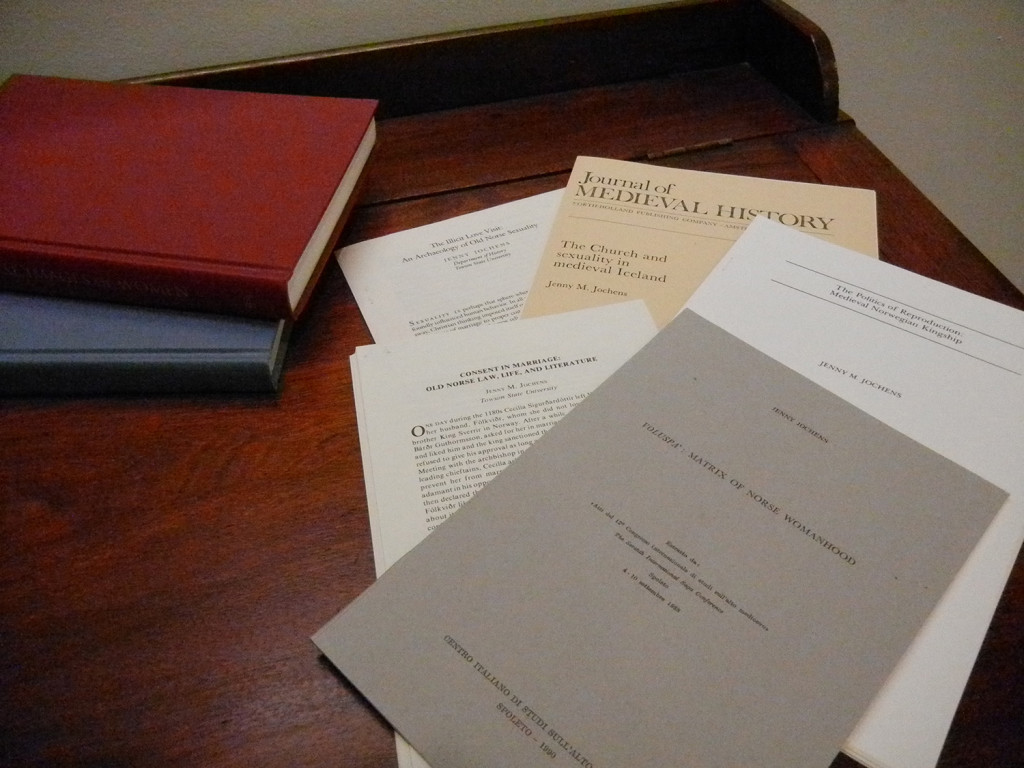Women in the middle ages are a particularly interesting subject that needs more specialized historians. This is what I discovered as I interviewed in the Fall of 2009 Professor Emerita Jenny Jochens, a medievalist living in Baltimore. She devoted her career precisely to the study of medieval women, particularly the Norse woman’s ideal imagery, and her not so ideal reality of life.
Jenny Jochens graduated from the University of Copenhagen in Denmark, where she was born. Professor Jochens considers her field of study to be Old Norse Society, but she didn’t always have this specialization. Before moving to America she had been in Paris, studying French medieval history. Her arrival in Baltimore was due to her husband being offered a job at Johns Hopkins University. Having moved here with four small children, Jochens needed somewhere close to work and ended up teaching at Towson University.
Then, in the 1970’s there was a growing interest from her and her female peers to create classes in women’s history. Soon they had to face the fact that there was no compiled women’s history and that they would have to create it. According to the words of Natalie Davis, a famous medievalist, historians until then had written mostly about the “women worthies,” those women who had done something worth writing about, the strong women hidden in a past written by men. This was the beginning of women’s studies, and those who were already masters in their field had to gather together and figure out what was there to teach about women outside those exceptional cases.
Going back to the women of the Norse sagas Professor Jochens had read at Copenhagen University, she rediscovered the strong and powerful women of Old Norse legend. She became interested in whether these sagas were truly conveying real women and so she translated her own primary documents to develop her analysis. Once Jochens was caught in Old Norse women, she never returned to French history.
The professor accomplished many things in contribution to Women’s history at Towson University and beyond. Together with colleague Elaine Hedges and a few others, she helped create a Women’s Studies Program at the university. Thus Towson was one of the first colleges to have such a program of study. Jochens and the other founders wanted the program to be interdisciplinary, and this intent soon influenced the way she taught, for instance getting involved in a class with biologists, psychologists, and members of other departments in order to cover the whole subject of women in society.
Professor Jochens’s path is even more unique in the fact that when she was studying Old Norse society, to her knowledge, in Baltimore she was the only specialist in her field. She couldn’t rely on anyone else to teach her what she needed to know. Therefore, she had to take the initiative to learn it! And learn she did. Professor Jochens authored two books pertaining to the life of women in the Norse Middle Ages. The first, Women in Old Norse Society, uses three main Norse sagas as a basis for the study of real female life according to law and religion, but also in leisure, sex, and work. Old Norse Images of Women, her second book, deals with images of women written by men, divine myths and legends about women. In her books I found she separated the real from the ideal, and the ideal from the not so ideal.
In both of her books, Women in Old Norse Society and Old Norse Images of Women, the professor explores the Germanic historical continuity. She believes there is a common root in the Germanic world that we can find in gender categories as well. In her interview, she further explained to me how all the Nordic peoples came from Germanic tribes. She described these people as the ones who tore apart the Roman Empire, then settled in Germany, England, Spain, and half of France. One can see that the “Germanic legacy is very large in Europe,” she said. Professor Jochens also explained how Germanic historical continuity was important to Icelandic history.
I found her second book, Old Norse Images of Women, to be particularly fascinating. As I explained, it doesn’t focus on the reality of women, but involves heroines, women creating, accomplishing, adventuring, and using their power, but all this within the imaginations of men. The book is divided into two parts: women of divine image, and women of human image. One divine image, for instance, was that of the fertility goddess. She was believed to be the first goddess entity. This stemmed from the fact that women have the primary role in the giving of life, and the men were given a minor role traditionally in this process. Other pre-pantheon ancient female figures were those that had wisdom and the power to predict the future. An example would be the Norns, or Nornir. These goddesses of fate saw the future of not just humanity, but “most likely the gods of the Nordic pantheon”11Jenny Jochens, Old Norse Images of Women, (Philadelphia: University of Pennsylvania Press, 1996), 39. that emerged later. There was also the Volur, wise female creatures often depicted as dead. They were “willing to share their wisdom when summoned by Gods, goddesses, or men”.22Ibid., 41. These powerful images of women seem inspiring, but the goddesses, much like Venus, were seen as whores by the other gods. They faced much adversity, their power limited by the lust of gods as well as the fear of men.
Human images of women in poems and ancient literature, on the other hand, would include the Avenger and the Whetter. “The depiction of Gudrun in heroic poetry”, Jochens notes, “offers a single and richly nuanced portrait of a woman whose original function was to take revenge.”((Jenny Jochens, Old Norse Images of Women, (Philadelphia: University of Pennsylvania Press, 1996),135)) Gudrun’s image also evolved over time, from a “5th century pagan woman intent on revenge for her brothers”33Ibid., 135.to a Christian wife undergoing ordeals to clear herself of a charge of adultery. Gudrun is said to have married the man who killed her brothers, and then set about sabotaging his life. This included killing her own children because they were of his blood. Another woman of note in the Old Norse poems was Brynhildr, whose image was of the Whetter. She was a “woman whose fame rested on murderous deeds of revenge that she achieved, however not by direct physical contact, but indirectly through speech acts of goading and inciting men to execute her purpose.”((Ibid., 162.))
When reading about these mythical and legendary women, a few questions came to my mind. In my interview with Jenny Jochens, I asked her why she thought men gave women ultimate wisdom, such as of the Volur and the Nornir. She replied that this may be rooted in little boys being raised by their mothers. The mother was the one who maintained the household when the man was away fighting. As one can imagine, that happened quite a lot in that time period. When a young boy had a question he asked a woman; even the language was taught by the mothers. In the case of the Prophetess image, she was a very important figure in legends because when the gods didn’t know, even they went to the woman oracle and asked advice. She concluded that it must be a tendency of men to connect women and justice, and it is prevalent even in our society today. This can be seen in the American symbol of justice, a woman holding the scales.
Another question that sprung from my readings of this book was whether women were affected by these stories, and if imitators of the avenger and the whetter images were prevalent in Norse society. It seems that there wasn’t much mimicry of the figure of the avenger, but Jochens suggested that the stories themselves are indicative of a larger problem in the Old Norse society, and indeed any medieval society. This dilemma was the loyalty of the woman to her kinship-based family or to the family that she started with her husband. In medieval times the woman sacrificed everything in marriage: home, siblings, parents, and identity. “The woman was up-rooted from all that she knew.”((Ibidem, 17.)) A woman might not even have married into the family of her choice, but she would be subjugated by that man’s family and become a second-class citizen even more than she was before she married.
While women were not known to become avengers, the image of the inciter is one that has been attributed to women not just in myth, but also by men in that society. The figure of the whetter or that of the inciter do not portray women in a good light. Men made these stories as excuses to claim that their mothers, sisters, or wives had convinced them to commit crimes, and that those bad actions were not the result of their own will. Women were used as scapegoats for some of the most atrocious decisions in history.

Box-shaped bronze brooch worn by Viking women to fasten their clothes, 9th to 11th centuries. © The Walters Art Museum
The other study that Jenny Jochens wrote, Women in Old Norse Society, touched on all aspects of the reality of medieval women’s lives. In particular, Jochens discusses in it the evolution of marriage in Nordic society. Germanic traditions of marriage practiced by tribes were often related to “marriage by capture.”44Jenny Jochens, interview by Danielle Jacob, October 12, 2009.In this period women were raped by traveling men – either going to war or wandering – and made pregnant. Then they were either kept as their companions, or not. Even the word used for marriage at the time indicated “violence at the origin of matrimony.”55Jenny Jochens, Women in Old Norse Society, (Ithaca: Cornell UIniversity Press, 1995), 18Germanic marriage also suggested a fundamental connection between marriage and property. The “bride price” was paid to the family in compensation for taking the woman, and in this way women were sold to their husbands with no right to refuse.(( Ibid., 22)) In addition to the cruelty of the process of marriage, the actual reality of marriage was bleak for any woman. There was “no minimum age for either bride or groom.”66Ibid., 36 If the female child was flawed while still young, the two parties would wait to see if she would outgrow her deformities. Although there were some laws restricting sexual promiscuity and harshly punishing the practice of incest and bigamy, the old traditions did persist for a long period of time, even during the process of conversion of these populations to Christianity. But Christian priests and monks were able to assure some respite for the medieval Icelandic woman. They tried to impose fidelity, consent, and indissolubility, but only succeeded fully in one aspect of their ideas.
Indissolubility was a major part of the Christian religious beliefs of marriage; this meant that once sanctified under God, this bond could only be broken unto death. In the end, however, the church had to make major concessions on the point of divorce, and did give powerful women the option of divorce in bad marriages. The other failing imposition of the church was the issue of fidelity, because while bigamy was illegal in Iceland, polygamy was widely practiced. In the end, the only successful feature of this Christian model of marriage was the practice of consent, where a woman had to consent to a marriage in order for the marriage to take place. This greatly improved the lives of women in medieval Norse society.
Among many other topics I approached with Professor Jochens, I tried to get a better sense of what a medievalist did. Following her recommendation, I looked up the site of the Medieval Academy. A medievalist is someone who researchers, publicizes, or teaches “medieval art, archaeology, history, law, literature, music, philosophy, religion, science, social and economic institutions, and all other aspects of the middle ages.”(( “About the Medieval Academy,” The Medieval Academy Website, http://www.medievalacademy.org/?page=About_Us, accessed December 4 2009)) There are many aspects to becoming a medievalist. A medievalist should concentrate on a specialized focus, either geographical (France, England, Norway, Italy, etc) or disciplinary (art, religion, history, music). One major requirement to being a medievalist is to study one or several languages, sometimes specific to one’s area of interest. Professor Jochens recommended proficiency in Latin, as all of Europe had its first writing experience in Latin.77Jenny Jochens, interview by Danielle Jacob, October 12, 2009.
Today, Professor Jochens spends her time between Paris and Baltimore, and she continues to write about the Middle Ages. The one major factor drawing her back to Baltimore is the Walters Art Museum. Professor Jochens says that the life of a medievalist is always difficult when away from Europe because the archives are there and a medievalist suffers from a “lack of tangible evidence”(( Jenny Jochens, interview by Danielle Jacob, October 12, 2009.)) in America. The museum, nonetheless, offers a plethora of sources that a medievalist could spend years surveying and studying. Baltimore has much to offer, she concluded, to the study of Medieval Europe.
Thank you, Professor Jochens, for taking the time to answer all my questions!
Jenny Jochens, Old Norse Images of Women, (Philadelphia: University of Pennsylvania Press, 1996), 39. ↩
Ibid., 41. ↩
Ibid., 135. ↩
Jenny Jochens, interview by Danielle Jacob, October 12, 2009 ↩
Jenny Jochens, Women in Old Norse Society, (Ithaca: Cornell UIniversity Press, 1995), 18 ↩
Ibid., 36 ↩
Jenny Jochens, interview by Danielle Jacob, October 12, 2009. ↩
 Medieval Baltimore
Medieval Baltimore


